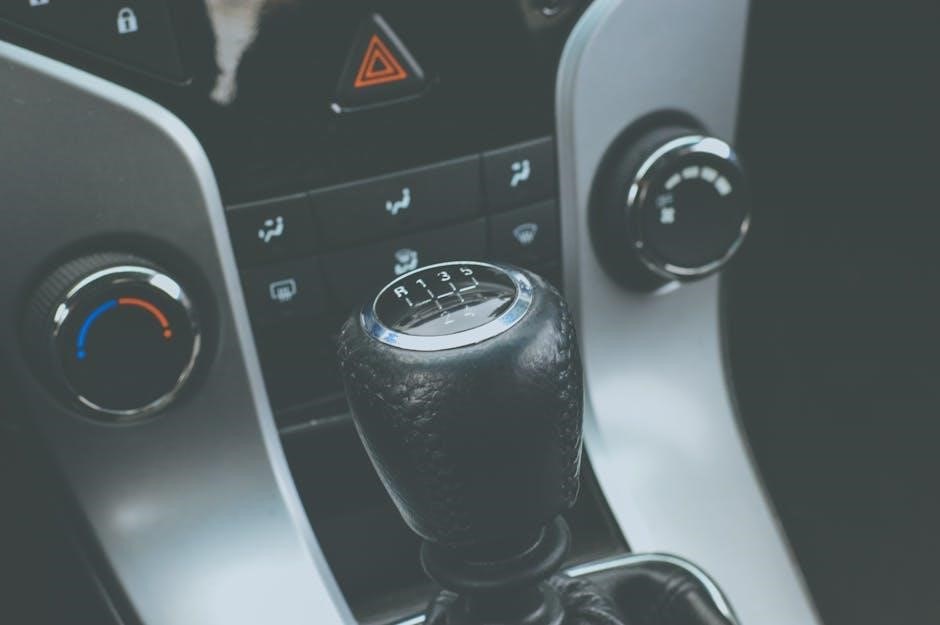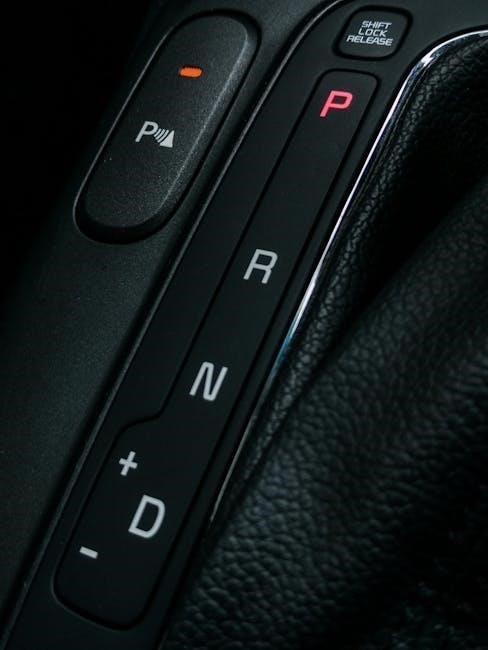Manual transmission driving lessons provide an essential skill for drivers, offering better control and understanding of vehicle mechanics. These lessons are structured to help learners master clutch control, gear shifting, and smooth acceleration. Regular practice and professional guidance ensure confidence and proficiency behind the wheel.
1.1 Benefits of Learning to Drive a Manual Transmission Car
Learning to drive a manual transmission car offers improved control over the vehicle, enhanced fuel efficiency, and a deeper connection to the driving experience. Manual cars are often more cost-effective to purchase and maintain compared to automatics. Additionally, mastering a manual transmission opens up more options when buying or renting cars, as many vehicles worldwide are manual. It also fosters better driving skills and situational awareness, making it a valuable skill for any driver;
1.2 Importance of Professional Driving Lessons for Manual Cars
Professional driving lessons for manual cars are crucial for mastering the unique skills required. Instructors provide a structured learning environment, helping to build confidence and competence. They offer personalized feedback on clutch control, gear shifting, and coordination. Professional lessons reduce the fear of stalling and improve overall driving efficiency. Additionally, instructors can address individual challenges, ensuring learners grasp proper techniques and develop safe driving habits. This guidance is invaluable for new drivers aiming to become proficient in manual transmission driving.

Understanding the Basics of Manual Transmission
Understanding the manual transmission involves knowing how the gearbox and clutch work together to control the car’s speed and torque, enabling smooth gear shifts and efficient driving.
2.1 How a Manual Gearbox Works
A manual gearbox operates by allowing the driver to manually select gears using the gear lever and clutch pedal. The clutch disconnects the engine from the transmission, enabling smooth gear changes without grinding. As the driver presses the clutch and shifts gears, the transmission adjusts the speed and torque according to the selected gear, ensuring efficient power delivery to the wheels. This mechanical process requires coordination and practice to master seamlessly.
2.2 The Role of the Clutch Pedal in Manual Driving
The clutch pedal plays a crucial role in manual driving by disconnecting the engine from the transmission. When pressed, it allows smooth gear changes without causing the gears to grind; The driver must press the clutch fully to shift gears and release it gradually while accelerating. Proper clutch control is essential for starting, stopping, and shifting gears seamlessly, making it a fundamental skill in mastering manual transmission driving.

Preparing for Your First Manual Driving Lesson
Ensure the vehicle is ready, familiarize yourself with controls, and wear comfortable shoes. Adjust the seat and mirrors for comfort. This preparation enhances your first lesson’s effectiveness.
3.1 Checking the Vehicle for Readiness
Before your first lesson, ensure the car is roadworthy. Check tire pressure, oil levels, and brakes. Confirm the parking brake works and the gearshift is in neutral. Familiarize yourself with the clutch, gears, and handbrake. Adjust mirrors and seat for comfort. Ensure all lights and signals function properly. A well-prepared vehicle ensures safety and focus during the lesson, allowing you to concentrate on learning manual driving techniques without unnecessary distractions.
3.2 Getting Familiar with the Controls of a Manual Car
Understand the clutch pedal, gearshift, and accelerator. The clutch disconnects the engine from the transmission, allowing smooth gear changes. The gearshift selects the desired gear, while the accelerator controls speed. Adjust the seat and mirrors for comfort and visibility. Familiarizing yourself with these controls is crucial for confident and effective driving. Proper adjustment ensures better control and reduces distractions during lessons.
Mastering the Core Skills of Manual Transmission

Mastering core skills involves smooth starts, stops, and gear shifts. Coordinate clutch release with accelerator input for seamless transitions. Practice controlling speed and torque for efficient driving.
4.1 Starting and Stopping Smoothly
Starting and stopping smoothly in a manual car requires precise coordination between the clutch and accelerator pedals. Begin by pressing the clutch fully down and shifting into first gear. Slowly release the clutch while gently pressing the accelerator to avoid stalling. When stopping, downshift before coming to a complete stop to maintain control. Practice these techniques consistently to ensure smooth starts and stops, building confidence and reducing the risk of stalling.
4.2 Shifting Gears and Coordinating the Clutch
Shifting gears smoothly requires coordination between the clutch pedal and gearstick. Press the clutch fully down before moving the gearstick into the desired gear. Release the clutch gradually while accelerating to avoid jerking. Listen to engine RPMs to determine the right time to shift. Practice shifting through all gears in a controlled environment to build muscle memory. Downshifting before stopping helps maintain control, while upshifting at the correct RPM enhances smooth acceleration. Consistent practice improves clutch and gear coordination, making driving more seamless and efficient.

Common Challenges in Learning Manual Transmission
Learners often face frustration with stalling, difficulty in smooth gear shifts, and coordinating clutch with accelerator. Consistent practice and patience are key to overcoming these hurdles.
5;1 Overcoming the Fear of Stalling the Car
Stalling is a common challenge for new manual drivers, but it’s not dangerous. Start by practicing in a safe, open area with no pressure. Focus on slow, deliberate clutch releases while gradually pressing the accelerator. Remember, stalling is part of the learning process and improves with time. Stay calm, and don’t rush the process. A patient instructor can guide you through this phase, helping you build confidence and master the clutch-accelerator coordination.
5.2 Mastering the Clutch and Gas Pedal Coordination
Coordinating the clutch and gas pedal is key to smooth manual driving. Practice slow, smooth clutch releases while pressing the accelerator simultaneously. Focus on the “biting point” where the engine starts to engage. In real-world scenarios, gradual pressure on both pedals ensures seamless gear shifts. Regular practice in various driving conditions helps develop muscle memory and improves coordination, reducing jerky movements and enhancing overall control of the vehicle. Patience and consistent practice are essential for mastering this skill.
Finding the Right Driving Instructor for Manual Lessons
Research local driving schools with experienced instructors for manual transmissions. Check reviews, qualifications, and ask for referrals to ensure a reliable and skilled teacher.
6.1 Qualities of a Good Manual Driving Instructor
A good manual driving instructor should have extensive experience with manual transmissions, excellent communication skills, and patience. They must provide clear, step-by-step guidance and adapt teaching methods to suit individual learning styles. Instructor should also have a calm and encouraging demeanor, ensuring learners feel comfortable and confident. Additionally, they should be knowledgeable about local driving laws and road conditions, offering practical tips for real-world scenarios.
6.2 Tips for Finding Local Manual Driving Schools
To find reliable local manual driving schools, start by searching online with keywords like “manual driving lessons near me.” Check reviews and ratings to assess quality. Visit the school’s website to confirm they specialize in manual transmission training. Ensure their instructors are certified and experienced. Ask about lesson packages and pricing to find a program that fits your budget and schedule. Additionally, inquire about their vehicle fleet to ensure they provide suitable cars for manual practice.

The Importance of Practice in Manual Driving
Regular practice is crucial for mastering manual driving, improving muscle memory, and ensuring smooth gear shifts. Consistent lessons help build confidence and refine driving skills effectively.
7.1 Scheduling Consistent Practice Sessions
Consistency is key to mastering manual driving. Schedule regular practice sessions, ideally 90-minute lessons weekly, to build muscle memory and improve coordination. Start in empty parking lots to focus on clutch control and gear shifts before progressing to public roads. Track progress and adjust sessions as skills develop. Regular practice ensures steady improvement and confidence behind the wheel.
7.2 Practicing in Public Roads vs. Empty Parking Lots
Beginners should start in empty parking lots to safely practice basic techniques like starting, stopping, and shifting gears without traffic stress. Once comfortable, transition to public roads to apply skills in real-world scenarios. Public roads help build adaptability and situational awareness, while parking lots provide a controlled environment for mastering fundamentals. Balancing both practice settings accelerates learning and confidence in manual driving.
Taking the Driving Test in a Manual Car
Taking the driving test in a manual car requires precise preparation. Practice smooth starts, stops, and gear shifts to ensure confidence and readiness for the examination.
8.1 What to Expect During the Manual Driving Test
The manual driving test evaluates your ability to smoothly operate a manual car. Expect to demonstrate starting from a standstill, shifting gears, stopping, and maneuvering in traffic. The examiner will assess your coordination of the clutch and accelerator, ensuring minimal jerking. You may also be asked to perform specific driving tasks, such as turning, merging, and parking. Consistent practice beforehand is key to performing confidently and avoiding common mistakes during the test.
8.2 Tips for Performing Confidently on Test Day
Arrive early and stay calm to avoid last-minute stress. Practice last-minute maneuvers like reversing and turning to build confidence. Focus on smooth clutch and accelerator coordination, as jerky movements can lower your score. Review driving laws and ensure you understand the test route. Take deep breaths, listen to instructions carefully, and maintain a steady pace. Proper use of gears and signals is essential. Consistent practice beforehand will help you stay composed and perform confidently during the test.

Advantages of Learning to Drive a Manual Car
Learning to drive a manual car offers better control, lower costs, and improved fuel efficiency. It enhances driver engagement and skill, making driving more enjoyable and rewarding.
9.1 Better Control Over the Vehicle
Driving a manual car provides exceptional control, allowing precise acceleration and gear selection. This direct connection enhances responsiveness, enabling smoother transitions and improved handling, especially on varied terrain. The ability to manually shift gears and use the clutch gives drivers greater command, reducing reliance on automatic systems. This heightened control fosters a deeper understanding of the vehicle’s mechanics, making driving more engaging and enjoyable while improving overall driving proficiency.
9.2 Cost-Effectiveness of Manual Cars
Manual transmission cars are often more affordable to purchase and maintain than automatics. They typically offer better fuel efficiency, reducing long-term operating costs. Additionally, manual vehicles tend to have fewer complex components, lowering repair expenses. This makes them a financially appealing choice for budget-conscious drivers. Learning to drive a manual car opens access to a wider range of cost-effective vehicles, providing economic benefits for years to come.
Mastery of manual transmission driving offers enhanced control, fuel efficiency, and driving enjoyment. Consistent practice and professional guidance ensure confidence and lifelong driving proficiency for learners.
10.1 Final Thoughts on Mastering Manual Driving
Mastery of manual driving unlocks a deeper connection with your vehicle, offering enhanced control and driving satisfaction. It requires patience, consistent practice, and dedication. Professional lessons provide a solid foundation, while real-world experience refines skills. Embrace challenges as learning opportunities and remember, proficiency comes with time. The journey to mastering manual driving is rewarding, leading to greater confidence and enjoyment on the road for years to come.

10.2 Encouragement for New Learners
Embracing manual driving can be challenging but incredibly rewarding. Stay patient and persistent, as every stall is a step toward mastery. Celebrate small victories, like smooth gear shifts or confident stops. Remember, even experienced drivers began where you are. With consistent practice and the right mindset, you’ll gain the skills and confidence to enjoy the freedom of driving a manual car. Keep going—you’re on the path to becoming a proficient driver!














































